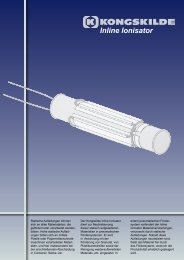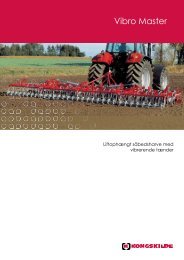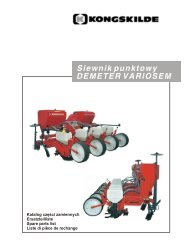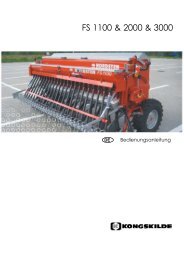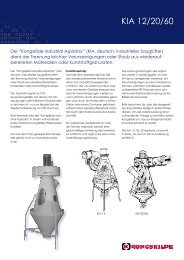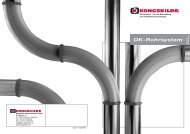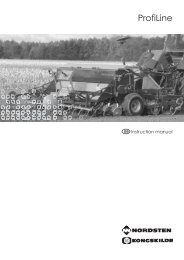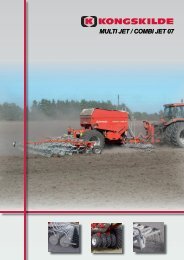Conveying Capacity - Kongskilde
Conveying Capacity - Kongskilde
Conveying Capacity - Kongskilde
You also want an ePaper? Increase the reach of your titles
YUMPU automatically turns print PDFs into web optimized ePapers that Google loves.
Maintenance<br />
Warning<br />
Always stop the machine prior to<br />
greasing, adjustment or repair.<br />
Greasing<br />
SUC 100E, SUC150E, SUC 200 E,<br />
SUC 300E:<br />
All bearings are lubricated for life<br />
and require no further greasing.<br />
SUC 500E:<br />
Grease the bearings on the blower<br />
belt side every 200 working hours.<br />
Use a lithium base grease of minimum<br />
quality as Mobil Mobilux EP2<br />
Belt Adjustment<br />
Check V-belt tension regularly, especially<br />
when they are new. New V-belts<br />
normally require adjustment after 15<br />
minutes and again after 2- 3 hours<br />
work.<br />
Belt tension check<br />
To inspect the V-belts remove the belt<br />
guard. Use, for instance, a tension<br />
tester to check the belts.<br />
Order No.: 121 130 071.<br />
Check the tension of all the belts. If it is<br />
not possible to adjust one set of belts<br />
so that all the belts have the proper<br />
tension the whole set must be replaced.<br />
SUC 100E,<br />
Blower:<br />
Depress one of the belts. At a deflection<br />
of 9.5 mm the force should be<br />
between 1.5 and 2 kg.<br />
Rotary valve:<br />
Depress one of the belts. At a deflection<br />
of 4 mm the force should be<br />
between 0.5 and 1 kg.<br />
6<br />
or Esso Beacon EP2. Regrease<br />
with approx. 20 cm 3 = 20 g each<br />
time. Never overgrease the bearings.<br />
If the casing is filled with too<br />
much grease, the bearing will get<br />
hot.<br />
Cleaning<br />
The screen inside the top of the<br />
cyclone should be cleaned regularly.<br />
The material conveyed will determine<br />
how often cleaning is required.<br />
If the screen is blocked the capacity<br />
of the blower will be reduced.<br />
SUC 150E,<br />
Blower:<br />
Depress one of the belts. At a deflection<br />
of 9 mm the force should be<br />
between 1.5 and 2.5 kg.<br />
Rotary valve:<br />
Depress one of the belts. At a deflection<br />
of 4 mm the force should be<br />
between 0.5 and 1 kg.<br />
SUC 200E,<br />
Blower:<br />
Depress one of the belts. At a deflection<br />
of 9 mm the force should be<br />
between 1.9 and 2.8 kg.<br />
Rotary valve:<br />
Depress one of the belts. At a deflection<br />
of 4 mm the force should be<br />
between 0.5 and 1 kg.<br />
SUC 300E,<br />
Blower:<br />
Depress one of the belts. At a deflection<br />
of 9 mm the force should be<br />
between 2 and 2.5 kg.<br />
Rotary valve:<br />
Depress one of the belts. At a deflection<br />
of 3.5 mm the force should be<br />
between 1 and 1.5 kg.<br />
SUC 500E,<br />
Blower:<br />
Depress one of the belts. At a deflection<br />
of 9.5 mm the force should be<br />
between 3 and 5 kg.<br />
Rotary valve:<br />
Depress one of the belts. At a deflection<br />
of 3.5 mm the force should be<br />
between 1.5 and 2 kg.<br />
Motors<br />
Do not cover up the motors. Keep<br />
them free of dirt reducing the cooling.<br />
Retightening<br />
On a new blower all bolts and<br />
screws are to be retightened after<br />
the first working day. Apart from<br />
that make sure that they are tight at<br />
all times.<br />
Storage<br />
Clean and grease the suction<br />
blower before storage.<br />
To prevent rust, store the machine<br />
in a dry place protected against<br />
wind and moisture.<br />
If the belts are too tight both the bearings<br />
and the belts will be overloaded and<br />
their life considerably reduced.<br />
If the belts are too slack they will slide<br />
on the belt pulleys and wear quickly. At<br />
the same time the blower will run too<br />
slowly reducing conveying capacity.<br />
How to use the tension meter<br />
1. Position the lower rubber ring at<br />
the deflection distance on the lower<br />
scale. Leave the upper rubber ring<br />
against the the edge of the sleeve.<br />
2. At center of span length apply force,<br />
with tension tester perpendicular<br />
to the span, large enough to make<br />
the deflection distance correspond<br />
to the edge of the adjacent belt. A<br />
straight edge across the belts will<br />
insure accuracy of reading.<br />
3. Remove the tension tester and<br />
read the deflection force on<br />
upper scale, at the top edge of<br />
the rubber ring.<br />
4. If the force is too high, belts should<br />
be slackened, and if the force is too<br />
low, belts should be tightened.<br />
Tightening of belts<br />
Make sure that the belt pulleys remain<br />
aligned during tightening. Check by<br />
putting a straight board against the pulleys<br />
to see whether both pulleys bear<br />
against the board.<br />
The rotary valva will remain aligned<br />
during belt tightening.



